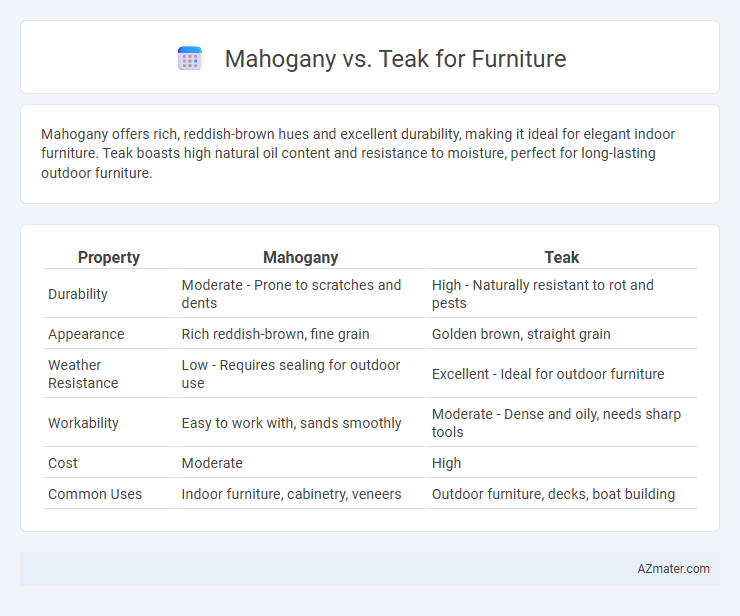Mahogany offers rich, reddish-brown hues and excellent durability, making it ideal for elegant indoor furniture. Teak boasts high natural oil content and resistance to moisture, perfect for long-lasting outdoor furniture.
Table of Comparison
| Property | Mahogany | Teak |
|---|---|---|
| Durability | Moderate - Prone to scratches and dents | High - Naturally resistant to rot and pests |
| Appearance | Rich reddish-brown, fine grain | Golden brown, straight grain |
| Weather Resistance | Low - Requires sealing for outdoor use | Excellent - Ideal for outdoor furniture |
| Workability | Easy to work with, sands smoothly | Moderate - Dense and oily, needs sharp tools |
| Cost | Moderate | High |
| Common Uses | Indoor furniture, cabinetry, veneers | Outdoor furniture, decks, boat building |
Introduction: Mahogany vs Teak for Furniture
Mahogany and teak are prized hardwoods renowned for their durability and rich aesthetics in furniture crafting. Mahogany features a deep reddish-brown hue with a fine, straight grain ideal for elegant indoor furniture, while teak offers exceptional resistance to moisture and pests, making it perfect for outdoor pieces. Both woods bring timeless beauty and strength, but teak's natural oils provide superior weather resistance compared to mahogany's softer finish.
Origins and Botanical Differences
Mahogany, primarily sourced from Central and South America, belongs to the Swietenia genus, known for its reddish-brown hue and fine grain, while Teak originates mainly from Southeast Asia, classified under the Tectona genus, distinguished by its golden brown color and natural oils that enhance durability. Botanically, Mahogany features a more uniform texture with interlocking grain patterns, whereas Teak has coarser grain and higher silica content, contributing to its exceptional resistance to water and pests. These botanical and geographic distinctions significantly influence their use in furniture, with Mahogany prized for its appearance and Teak favored for outdoor durability.
Appearance and Color Comparison
Mahogany features a rich, reddish-brown hue that deepens gracefully over time, providing a warm and elegant aesthetic ideal for classic and traditional furniture designs. Teak displays a golden-brown to medium brown color with natural oily textures, offering a sleek and modern look while maintaining durability and resistance to moisture. The choice between mahogany and teak depends on preferred tones and styles, with mahogany providing a darker, more luxurious appearance and teak offering lighter, more contemporary visuals.
Durability and Strength
Mahogany offers excellent durability with moderate resistance to rot and insect damage, making it suitable for indoor furniture that requires a fine finish and polish. Teak is renowned for its superior strength and exceptional durability, naturally resistant to moisture, decay, and pests, making it ideal for both indoor and outdoor furniture. The dense oily nature of teak wood contributes to its resilience against weathering, ensuring long-lasting performance in harsher environments compared to mahogany.
Resistance to Pests and Decay
Mahogany wood offers moderate resistance to pests and decay, making it suitable for indoor furniture with proper maintenance. Teak wood is highly resistant to termites, fungi, and moisture due to its natural oils, making it ideal for outdoor and high-humidity environments. This superior durability allows teak furniture to last longer and require less treatment compared to mahogany.
Workability and Craftsmanship
Mahogany offers excellent workability due to its fine, straight grain and softer texture, making it ideal for intricate craftsmanship and detailed carving. Teak is dense and oily, providing high durability but requiring specialized tools and techniques to achieve precise finishes. Craftsmen favor mahogany for ease of shaping, while teak's natural oils demand experience to maintain smooth surfaces and resist wear.
Maintenance and Long-Term Care
Mahogany furniture requires regular cleaning and occasional polishing to maintain its rich color and prevent drying, while teak furniture demands less frequent maintenance due to its natural oils that resist moisture and pests, making it ideal for outdoor use. Over time, teak develops a naturally appealing silver-gray patina if left untreated, whereas mahogany retains its deep, reddish-brown hue with consistent care and protection from direct sunlight. For long-term durability, sealing mahogany can protect against scratches and fading, whereas teak's resilience and weather resistance minimize the need for refinishing.
Sustainability and Environmental Impact
Mahogany and teak differ significantly in sustainability and environmental impact, with teak often sourced from plantations promoting reforestation, while genuine mahogany faces challenges due to overharvesting and illegal logging in tropical rainforests. Teak's natural oils provide durability that reduces the need for chemical treatments, enhancing its eco-friendliness compared to mahogany, which typically requires more finishing products. Choosing certified teak from FSC or PEFC sources supports sustainable forestry practices, whereas the supply chain for mahogany remains less regulated, raising concerns about biodiversity loss and habitat destruction.
Cost and Value Considerations
Mahogany furniture typically costs more upfront due to its rich color and fine grain but offers excellent durability and long-term value for heirloom pieces. Teak is often priced higher because of its natural oils and resistance to moisture, making it ideal for outdoor use with minimal maintenance costs over time. Evaluating cost versus value should consider the furniture's intended environment and lifespan, with mahogany favored for indoor luxury and teak for resilient outdoor applications.
Which Wood is Best for Your Furniture?
Mahogany offers rich color and fine grain, making it ideal for elegant, durable furniture, while teak is renowned for its natural oils and weather resistance, perfect for outdoor pieces. Teak's high silica content provides superior resistance to decay and insects, whereas mahogany's stability and workability favor detailed indoor craftsmanship. Choosing between mahogany and teak depends on your furniture's intended use, with teak excelling outdoors and mahogany preferred for sophisticated indoor designs.

Infographic: Mahogany vs Teak for Furniture
 azmater.com
azmater.com